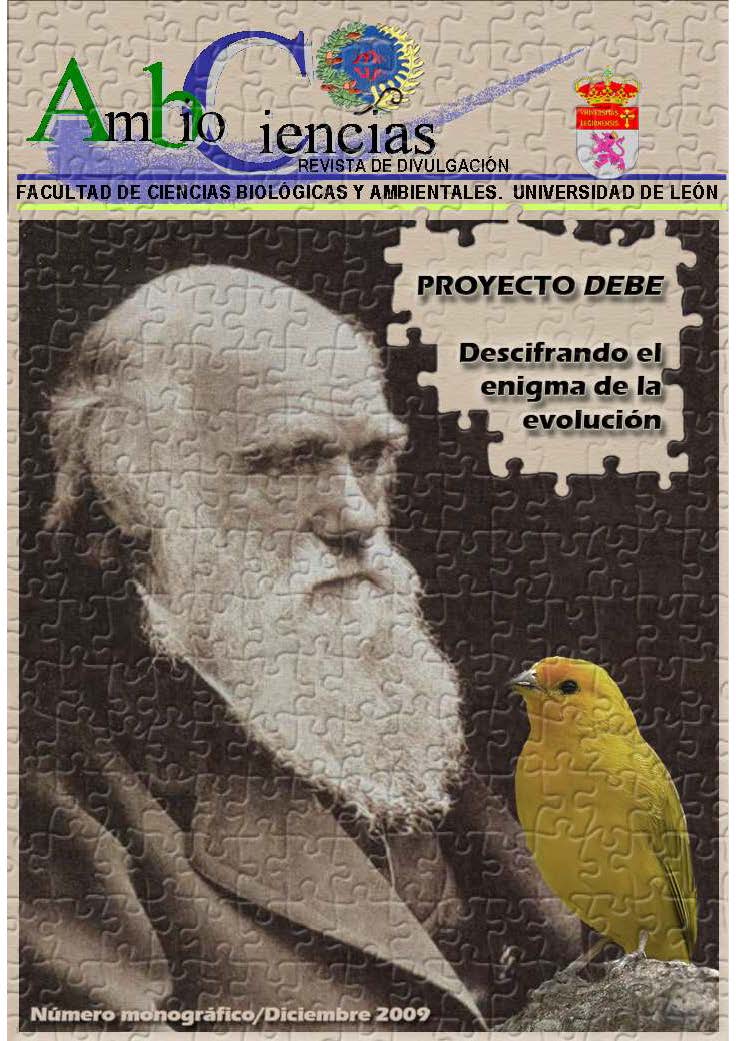Darwin también era botánico
DOI :
https://doi.org/10.18002/ambioc.i2009.4969Mots-clés :
Botánica, Darwin, Charles, 1809-1882,Résumé
Reivindicación de la figura de Darwin como botánico, muchas veces ignorada por el público en general, además el autor llama la atención sobre la gran deuda que tienen todos los botánicos con él.Téléchargements
Références
Ayres, P. (2008) The aliveness of plants: the Darwins at the dawn of plant science. Pickering and Chatto (Londres).
Berendse, F., Marten, S. (2009) The angiosperm radiation revisited, an ecological explanation for Darwin’s ‘abominable mystery’. Ecology Letters 12: 865–872.
Cesaro, A.C., Thompson, J.D. (2004) Darwin's cross-promotion hypothesis and the evolution of stylar polymorphism. Ecology Letters 7: 1209-1215.
Darwin Correspondence Project. http://www.darwinproject.ac.uk/home.
Duncan, R.P., Williams, P.A. (2002) Darwin's naturalization hypothesis challenged. Nature 417 (6889): 608-609.
Friedman, W.E. (2009) The meaning of Darwin’s abominable mystery. American Journal of Botany 96: 5–21.
Gibson, T.C., Waller, D.M. (2009) Evolving Darwin’s ‘most wonderful’ plant: ecological steps to a snap-trap. New Phytologist 183: 575–587.
Harder, L.D., Johnson, S.D. (2009) Darwin’s beautiful contrivances: evolutionary and functional evidence for floral adaptation. New Phytologist 183: 530–545.
Howard, J.C. (2009) Why didn’t Darwin discover Mendel’s laws? Journal of Biology, 8:15 (doi:10.1186/jbiol123).
Kutschera, U., Briggs, W.R. (2009) From Charles Darwin’s botanical countryhouse studies to modern plant biology. Plant Biology 11: 785–795.
Lambdon, P.W., Hulme, P.E. (2006) How strongly do interactions with closelyrelated native species influence plant invasions? Darwin's naturalization hypothesis assessed on Mediterranean islands. Journal of Biogeography 33: 1116- 1125.
Luo, Z., Zhang, D., Renner, S.S. (2008) Why two kinds of stamens in buzzpollinated flowers? Experimental support for Darwin's division-of-labour hypothesis. Functional Ecology 22: 794-800.
Pannell, J.R. (2009) On the problems of a closed marriage: celebrating Darwin 200. Biology Letters 5: 332-335.
Pauw, A., Stofberg, J., Waterman, R.J. (2009) Flies and flowers in Darwin’s race. Evolution 63: 268–279.
Pérez-Barrales, R., Vargas, P., Arroyo, J. (2006) New evidence for the Darwinian hypothesis of heterostyly: breeding systems and pollinators in Narcissus sect. Apodanthi. New Phytologist 171: 553-567.
Peter, C.I., Johnson, S.D. (2006) Doing the twist: a test of Darwin's crosspollination hypothesis for pollination reconfiguration. Biology Letters 2: 65-68.
Pickersgill, B. (2009) Domestication of plants revisited – Darwin to the present day. Botanical Journal of the Linnean Society 161: 203–212.
Riba, M., Mayol, M., Giles, B.E., y col. (2009) Darwin's wind hypothesis: does it work for plant dispersal in fragmented habitats? New Phytologist 183: 667-677.
The Complete Work of Charles Darwin Online. http://darwin-online.org.uk/
Villagrán, C.A. (2001) Un modelo de la historia de la vegetación de la Cordillera dela Costa de Chile central-sur: la hipótesis glacial de Darwin. Revista Chilena de Historia Natural 74: 793-803.
Téléchargements
Publiée
Comment citer
Numéro
Rubrique
Licence
(c) Tous droits réservés Juan Arroyo Marín 2009

Ce travail est disponible sous licence Creative Commons Attribution - Pas d’Utilisation Commerciale - Partage dans les Mêmes Conditions 4.0 International.
Los autores que publican en esta revista están de acuerdo con los siguientes términos:
- Los autores ceden de forma no exclusiva los derechos de explotación (reproducción, distribución, comunicación pública, transformación) a la Universidad de León, por lo que pueden establecer, por separado, acuerdos adicionales para la distribución no exclusiva de la versión de la obra publicada en la revista (por ejemplo, alojarlo en un repositorio institucional o publicarlo en un libro), con un reconocimiento de su publicación inicial en esta revista.
- Este trabajo se encuentra bajo la Creative Commons Attribution-NonCommercial-ShareAlike 4.0 International License. Puede consultarse desde aquí la versión informativa y el texto legal de la licencia.
- Se permite y se anima a los autores a difundir electrónicamente las versiones pre-print (versión antes de ser evaluada) y/o post-print (versión evaluada y aceptada para su publicación) de sus obras antes de su publicación, ya que favorece su circulación y difusión más temprana y con ello un posible aumento en su citación y alcance entre la comunidad académica.







